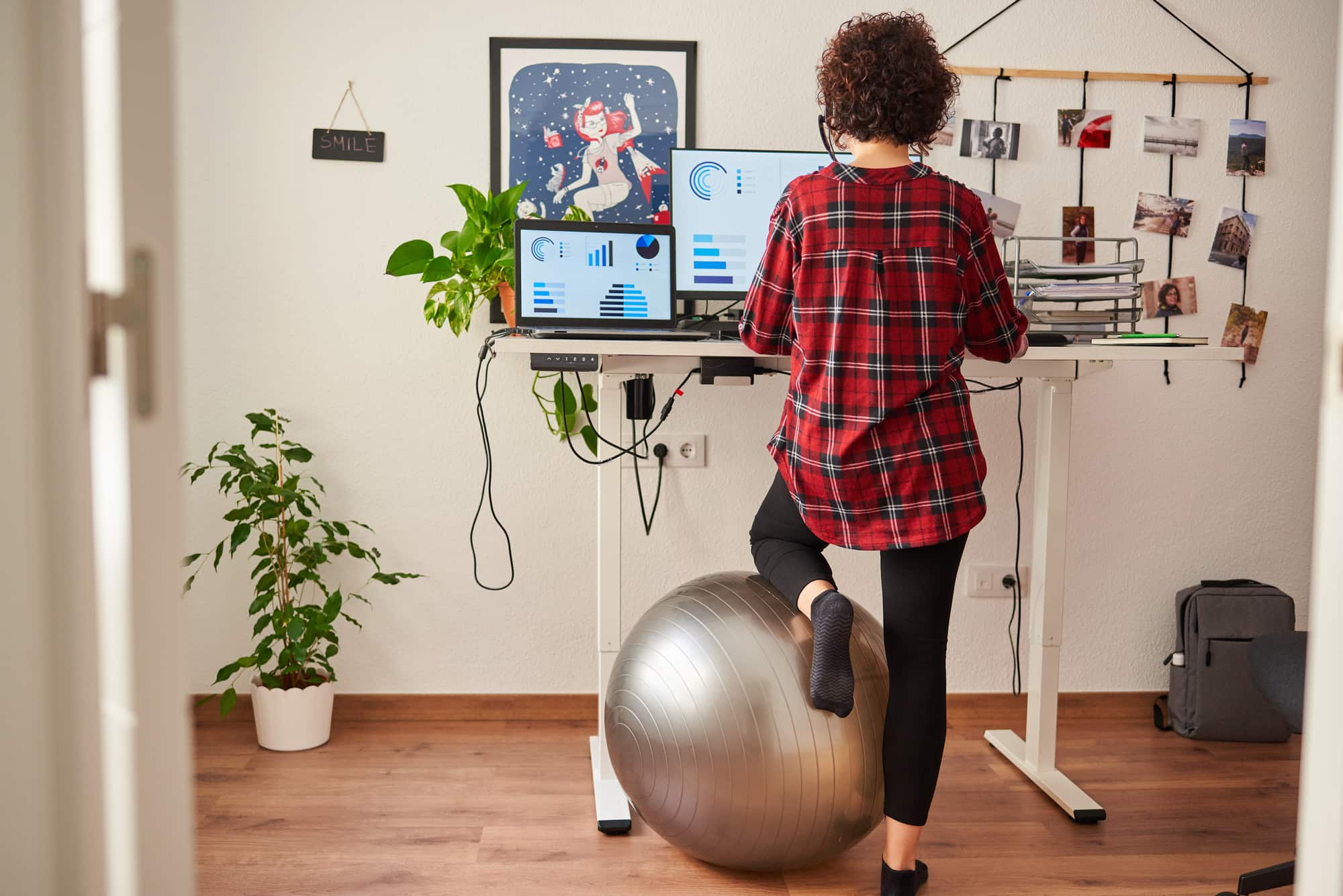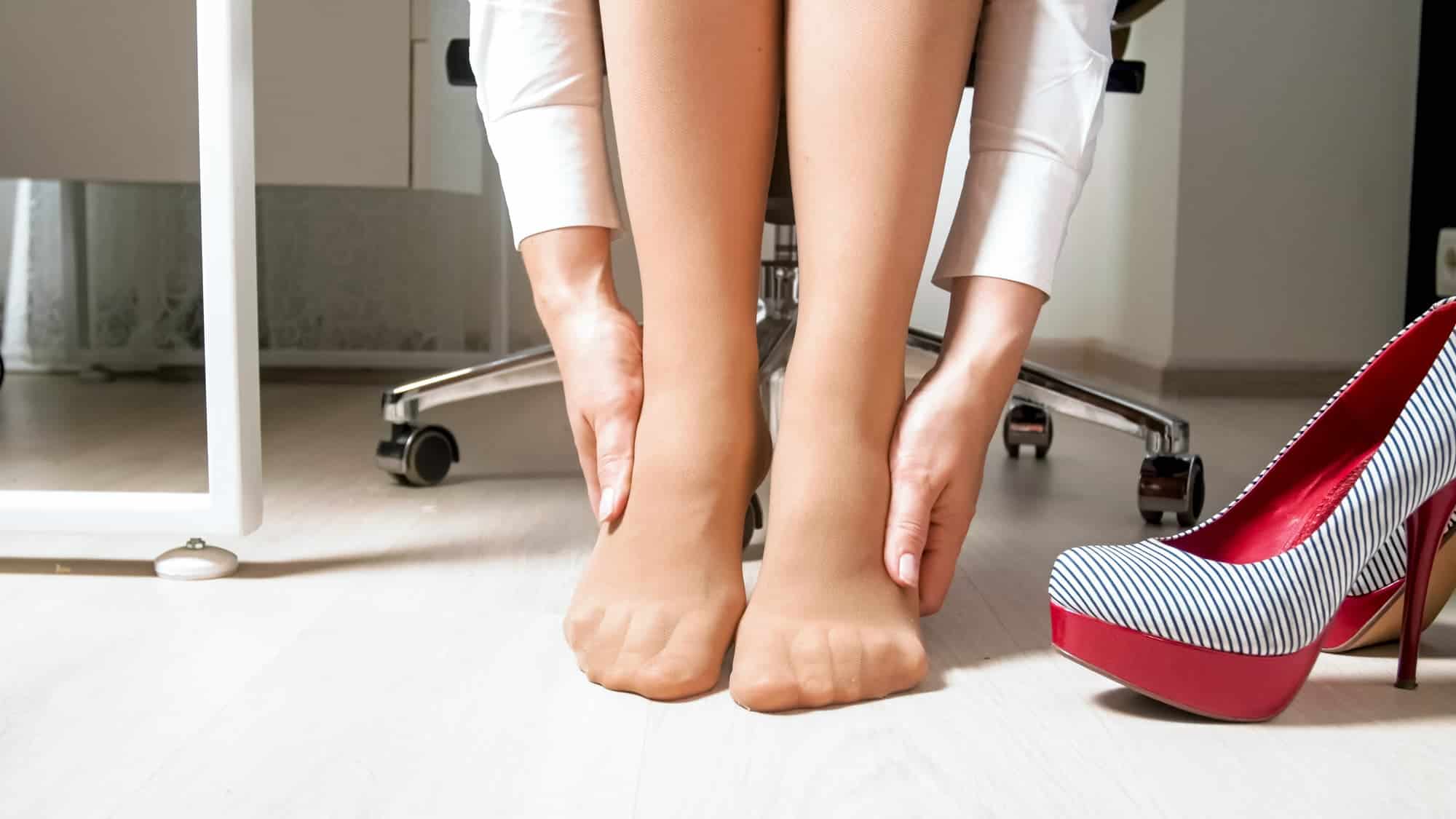Standing desks are among the fastest-growing employee benefits in many offices and workplaces. Some would pair it with an anti-fatigue mat or ergonomic work chair to boost the effects.
Now, if you’re using one in the office, you might be wondering: should I wear shoes when using standing desk? Will it help me work better, too?
This article has the insights you need to know more and decide.
Preferences Still Matter
One’s personal preferences still matter when we talk about standing desks and the barefoot vs shoe debate. Some are comfortable using the standing desk barefoot, while some prefer wearing sensible shoes.
People who go barefoot often supplement their standing desk use with anti-fatigue mats for comfort. Some shoe-wearing workers also make use of anti-fatigue mats.
Still, others wear compressions socks or shoe inserts to make standing on hard or carpeted surfaces more tolerable.
If you are still undecided on which method to try, we suggest reading the rest of this article. Hopefully, by the end of this post, you have settled on a set-up that is most feasible and comfortable for you.
Standing Barefoot vs Standing With Shoes: Which Is Better?
Medical research has noted that standing desk use resulted in several health benefits. These include calorie burn, physical activity promotion and improved productivity.
Despite these health advantages, you may not be able to get the most out of it if you’re not using the standing desk properly.
Is standing barefoot at your standing desk better than standing with shoes? For some, standing barefoot is preferable over standing with shoes, especially if the footwear is uncomfortable and lacks support.
The ground you’re standing on will likely affect your experience, too.

Is Going Barefoot At Standing Desk Harmful?
Standing barefoot on a hard surface such as wood or tiles should give adequate support for your feet. But prolonged standing on this type of surface will likely cause pain on your legs, shins and heels.
When this occurs, the constant need to sit down only outweighs the benefits of using a standing desk.
Also, if you work in a carpeted office, standing barefoot will leave body moisture and residue on the carpet. Over time, this will lead to dirt build-up, creating a breeding ground for bacteria.
Is Wearing Shoes While On A Standing Desk Harmful?
Wearing shoes while working on a standing desk provides feet support and comfort. It can also prevent back pain while encouraging a healthy work environment.
But the kind of shoes you use when working using a standing desk will significantly affect your experience.
According to one study, standing while wearing unstable footwear will increase overall postural sway. This condition refers to the fluctuation in body angle that occurs when the person stands upright.
Moreover, the study indicated that traditional shoes overprotect the foot and cause smaller foot muscles to deteriorate.
This study also stressed the importance of wearing a shoe design that suits prolonged standing.
On top of wearing uncomfortable shoes, prolonged standing is by itself harmful. One particular research revealed that standing for hours in the workplace result in various health issues.
These include low back pain, muscle pain, leg swelling, physical fatigue and body discomfort.
The study also stated that prolonged standing leads to a higher risk of low back pain, cardiovascular problems and pregnancy issues.
However, there are several interventions that can help avoid these health conditions. These include the use of sit-stand workstations, shoe inserts and compression stockings.
Doing all sorts of movement or physical activity during work also helps.
Is There Any Difference Between Standing On Hard Floor vs Carpeted Floor?
Standing on a hard floor at work can be painful for your feet. This surface type leads to reduced natural shock absorption and over-flattening, or overpronation, of the foot.
In addition, the hard floor can intensify back pain or cause postural stress — the most common cause of back pain.
In contrast, standing on a carpeted floor is better for your feet, according to a Swedish study. The research analysed various flooring materials and identified how these surfaces absorb shock.
Findings showed that soft floor coverings provide better support and significantly reduce pain in the feet, ankles, knees and back.

What Shoes Are Recommended When Using A Standing Desk?
Based on expert views and research, we can deduce that wearing comfortable shoes is better when using standing desks. This consideration is not sufficient, though.
Many opt for a pair of tennis shoes or sneakers for comfort. But you also need to consider which type of shoes can provide better support, especially during prolonged standing.
Among the most popular options are barefoot shoes. These are ideal for everyday use when using a standing desk.
This footwear typically lacks arch support or extra cushioning, which feels more natural and comfy. It naturally absorbs shock and provides comfort while you’re standing.
Aside from shoe design, consider finding a durable pair as well. Even though you’ll just be standing all day, it doesn’t mean that your shoes won’t wear out.
So, choose a comfortable pair made of high-quality materials and designed for prolonged standing.
Lightweight shoe construction is another factor to consider when selecting the ideal footwear. Without the added shoe weight, you’ll be able to stay on your feet for longer.
Lighter footwear will less likely cause discomfort or pain, too.
8 Ways To Help With Getting Used To Using Standing Desk
Aside from wearing suitable shoes, here are other ways to optimise your standing desk experience.
1. Focus on correct posture.
Proper posture while using the standing desk means keeping your feet flat and shoulder-width apart, shoulders relaxed, and knees straight but not locked. Avoid leaning forward or backward. Try not to slump, either.
2. Don’t try to stand all day.
Stand then sit from time to time. This constant sit-stand transition is more sustainable than standing for 4 hours straight. The key is to listen to your body and change positions when needed.
3. Use the ideal standing-to-sitting ratio.
Ideally, spend an hour standing for every one to two hours of sitting. Shifting positions at work should help boost productivity and lessen discomfort.
4. Incorporate ergonomics.
A typical standing workstation will have a fixed-height desk that you can adjust according to your comfort and preference. Proper computer screen positioning also improves comfort and minimise injury or pain. Your hands, wrists and forearms should be straight and parallel to the floor as well.

5. Avoid staying still.
Move around and incorporate as many small movements as possible. Stretching once in a while can also ease tension in the body. Walk and move around whenever you can and avoid leaning to one side for long periods.
6. Consider getting an anti-fatigue mat.
Consider using an anti-fatigue mat if you have a standing desk on a hard floor surface. It will help absorb some of the pressure brought about by standing. However, this may not work for everyone. Try it out first and see how it goes.
7. Do stretches.
Stretching exercises help you get used to a standing desk. While standing, try doing leg stretches to improve your flexibility. Stretch your neck, arms, shoulders and back when you can, whether you are sitting down or standing.
8. Use a balance board.
You may also benefit from a balance board while using a standing desk at work. When choosing a balance board, pick one with non-slip features for safety. A balance board with a limited range of motion will also keep you from being distracted.
Transitioning to a standing desk setup is relatively easy but not pain-free. The initial adjustment period will likely lead to minor discomfort like sore feet, tired legs and shaky calves.
On average, it may take you around two weeks to comfortably use the desk and stand while working. You might experience early fatigue at first. But these tips and the right footwear should help you adjust.
Conclusion
As long as it’s done right, using a standing desk provides a range of work and health benefits. But the most important thing to remember is that you should be comfortable.
And one way to do this is by working with the right shoes. Aside from footwear design, pick durable and lightweight pairs with enough feet support.
Then, don’t forget to stretch, walk around and take breaks when necessary.
Informative Q&A
1. Will using a standing desk help back pain?
Using a standing desk can help with back pain. One research showed that standing desks allow employees to sit and stand from time to time, which help relieve neck and back pain.
Moreover, the participants noted that it’s easier to sit and stand at work with a standing desk present.
2. Will a standing desk help with neck pain?
Research by CDC concluded that sitting time reduction helps alleviate back and neck pain by 54% and improves mood states. Their findings also suggested that a sit-stand device will make this possible plus lessen sedentary behaviours among workers.
- 6 Benefits of Using Seat Cushion - February 20, 2024
- 4 Tips to Fix Uncomfortable Chair - February 19, 2024
- How to Position Lumbar Support on Ergonomic Chair - February 15, 2024

